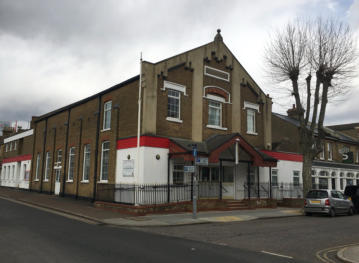The Salvation Army
Persecution Years - Southend-on-Sea
The
Salvation
Army,
was
founded
in
1878,
when
William
Booth
changed
their
name
from
The
Christian
Mission
and
the
organisation
adopted
a
military
structure
and
the
wearing
of
uniforms
we
are
so
familiar
with
today.
Their
doctrine
of
practical
Christianity
"soup,
soap
and
salvation"
was
to
be
the
foundation of their organisation.
Having
first
established
themselves
nearby
at
Shoeburyness
and
Wakering,
under
the
command
of
a
Captain
Zeally,
the
decision
was
taken
in
1883
to
include
Southend-on-Sea.
Their
first
meetings
were
held
in
a
laundry
in
Queens
Road.
The
arrival
of
this
working
class
evangelical
religion
was
far
from
welcome.
All
denominations
in
the
town
joined
forces
to
encourage
demonstrations
against
them.
During
this
period,
worship
was
often
linked
to
an
individuals
social
standing.
The
more
educated
and
affluent
citizens
of
our
town,
belonged
to
the
established
church,
those
lower
down
the
social
scale
attended
the
Congregational
church,
Cliff
Town,
in
Nelson
Road.
The
labouring
classes, if they bothered at all, supported the Methodists or the Peculiar People.
Although
the
Salvation
Army
held
some
of
their
meetings
for
members
inside,
they
were
well
known
for
going
into
public
houses
to
preach
abstinence
from
alcoholic
beverages,
and
for
holding
open
air
meetings.
Much
to
the
annoyance
of
members
of
the
public.
In
the
autumn
of
1894,
traders
had
become
indignant
and
voiced
their
displeasure
at
their
regular
meetings
held
at
the
High
Street
end
of
York
Road,
every
Monday
evening.
A
Mr
Cummings
took
matters
further
by
borrowing
a
horse
and
trap
and
by
way
of
practical
protest,
commenced
to
drive
through
and
disrupt
the
service.
His
passage
back
and
forth
did
little
to
deter
the
assembled
Salvationists.
This
would
not
be
the
last
time
they
would
have
a
form
of
transport
driven
through
their
ranks.
As
late
as
1923,
a
motorist,
one
James
Weedon,
was
driving
his
car
up
the
High
Street,
when
he
found
his
way
his
way
blocked
by
one
of
their
processions.
In
a
attempt
to
clear
a
passage,
he,
drove
his
vehicle
at
the
Salvationists,
scattering
them
in
all
directions.
The
crowd
became
hostile,
mounted
the
footboard
of
the
car
and
dragged
out,
not
the
driver,
but
his
passenger,
Frederick
Sampson,
(Weedons
employer)
who
had
been
heard
urging
him
to
drive
through
the
ongoing
march.
Both
men
were
arrested,
Weedon
charged
with
dangerous driving and later fined £3, Samson however, was fined £10.
A
notably
change
was
the
watching
crowd
attacked
the
passengers
in
the
their
car,
rather
than
the
Salvation
Army.
Some
years
prior,
the following report appeared in the local paper:
Guarded
by
police,
the
Salvationists
-
joined
by
others
from
outlying
areas
and
London
-
marched
down
Southend
High
Street,
accompanied
by
their
band
and
the
singing
of
hymns,
to
the
Public
Hall
in
Alexander
Street.
The
crowd
that
gathered
to
watch,
were
hostile
and
many
threw
rotten
eggs,
flour
and
soot
at
the
passing
procession.
Police
were
forced
to
make
arrests
when
members
of
the
Army
were
physically
assaulted.
Reaching
the
Public
Hall
their
way
was
blocked
by
some
500
people
belonging
to
the
"Skeleton
Army"
of
whom
among
their
number
were
so
called
respectable
citizens.
Once
inside
the
Hall,
the
mob
continued
with
their
heckling,
shouting
and
verbal
abuse,
in
order
to
disrupt
the
meeting.
Many
of
the
protesters
were
charged
with
"wilfully
obstructing
the
free
passage
of
the
highway,
Southend"
At
the
end
of
their
gathering,
police
had
to
protect
the
army,
by
marching
them
to
a
field
near
Lukers Brewery where they were able to disperse.
A truly shocking and no doubt frightening experience for the Salvationists.
One
very
busy
Bank
Holiday
in
the
early
1900s,
the
Salvation
Army
found
themselves
on
the
wrong
side
of
the
law,
when
they
positioned
themselves
across
the
bottom
of
Pier
Hill.
This
was
to
prevent
the
hordes
of
trippers
coming
off
the
trains
from
London,
making
their
way
to
the
seafront
and
the
many
drinking
establishments
on
Marine
Parade.
As
numbers
increased
and
the
queue
became
longer
the
huge
numbers
of
people
tried
to
push
forward.
Tempers
became
frayed
and
in
order
to
stop
a
riot,
the
Police
were
called. The Salvation Army were charged with obstruction and ordered to disperse.
The
Citadel
we
see
today,
on
the
corner
of
Clarence
Street
and
Clarence
Road,
was
built
on
land
purchased
for
£575
with
a
stone
laying ceremony held in 1888. Visitors came from far and wide, including the founders son Chief of Staff, Bramwell Booth.

By Carol Edwards

Salvation
Army
corner
of
Clarence
Street
and
Clarence
Road Southend
Southend Timeline Southend-on-Sea © 2009 - 2024. All Rights Reserved



SOUTHEND CITY

Southend-on-Sea’s No 1 History Website! Documenting The Town & The Townspeople
Now Incorporating The Sea Of Change Website
Website Info:


Chalkwell ▪ Eastwood ▪ Leigh-on-Sea ▪ Prittlewell ▪ Shoeburyness ▪ Southchurch ▪ Thorpe Bay ▪ Westcliff-on-Sea
































































